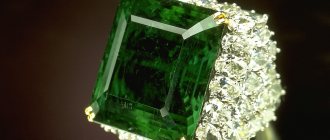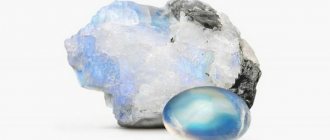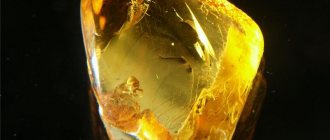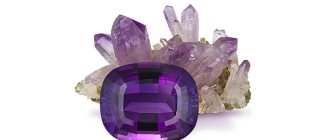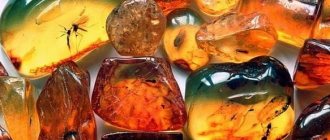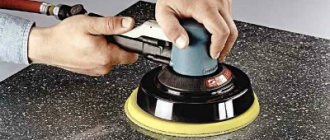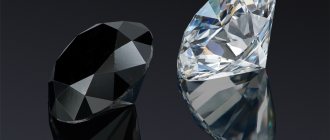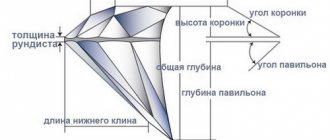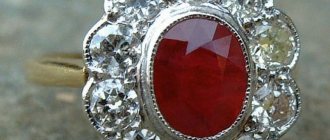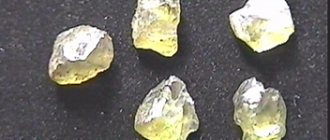Good afternoon, dear readers! Do you have turquoise jewelry? Are you sure of its authenticity? This question has good reason. The fact is that for many centuries this stone has remained one of the most popular and beloved, and therefore it is not surprising that there are such a large number of fakes of an unusual gem on the market - scammers have no qualms about taking advantage of the increased demand for the mineral. In this article we will tell you how not to be deceived - how to distinguish turquoise from a fake.
Characteristics of gems
Turquoise is a semi-precious mineral. Everyone strives to acquire it, because it is believed that the stone is a symbol of happiness and good luck.
Features of natural samples:
- rare examples of large whole breed;
- high price;
- wide color spectrum of blue shades;
- sufficient hardness – up to 6 units;
- complete opacity of the structure;
- shine is similar to wax objects;
- requires a certain temperature state of the environment;
- afraid of the humidity of the air environment;
- should not be left in direct sunlight;
- deteriorates from contact with chemical compositions of cosmetics.
Sea-green minerals are considered the most beautiful, but it all depends on the taste preferences of the buyer. Some people prefer pale and delicate blue products, while others will choose rich blue.
Who is suitable according to their zodiac sign?
According to astrologers, howlite is suitable for Virgo, Taurus, Capricorn and Scorpio. The gem influences them in such a way that representatives of these zodiac signs immediately feel a surge of strength and energy. The stone attracts good luck, promotes career success, helps to make only the right decisions, enhances positive character traits and neutralizes negative ones.
Ways to distinguish pressed types of gems
Real turquoise can be found in jewelry in the form of a pressed material. They are inexpensive. The stone is broken into crumbs, which are then combined with substances that perform painting and gluing of particles - resins. The workpiece turns out bright and interesting. In color it will be inferior to natural samples. Such gems remain popular and in demand. It is not difficult to distinguish a craft if you know several testing methods.
- Glass. When a glass product hits a surface or other glass, it produces a special, specific sound. Glass clinking distinguishes a fake.
- Plastic. You can check the plastic with a hot needle. It will either be punctured or melted.
It is difficult to counterfeit small beads, approximately 0.5 cm. Large pressed products are easier to counterfeit.
What tools will help determine the authenticity of a gem:
- Wet wipes. The mineral in the jewelry is wiped with damp cloths. If the napkin changes color, it means the material has been dyed. Natural turquoise is not afraid of water.
- Cotton wool and alcohol. Sometimes coloring is done efficiently. Then there will be no traces of water on the fabric or paper. You can wipe the surface of the product with alcohol. Fake minerals leave a mark in the form of a stain. The natural stone will remain unchanged.
- Matches. The most effective method is an open flame. But such an experiment must be carried out very carefully. If the product is made from counterfeit materials, it will melt. In addition, the fake emits an unpleasant odor. A natural gem turns pale when exposed to hot objects, and resin or wax appears on top. Chalcedony and glass materials decrease in size and are erased, but there will be no scratches on the top layer.
More often than not, jewelry made from turquoise stone looks very beautiful. I don't want to expose the product to damage. Therefore, I want any check to be gentle. An ordinary magnifying glass or microscope will be such an assistant. Natural turquoise is porous in structure. The changes will indicate what breed is being studied.
What to pay attention to:
- small bubbles - glass;
- veins darker than the main color - fake;
- dark spots – magnesite treated with salt or copper;
- high density – lazulite;
- bright glass luster – variscite.
How to check authenticity at home
If the jewelry has already been purchased, but the nature of the origin of the stones is in doubt, then more accurate and extreme methods of determining originality are used: heating or testing for strength. These methods are applicable at home because they entail damage to the mineral, which the store seller will not allow.
Ways to check the origin of a stone:
- Decoration made from plastic or plastic is usually painted with paint that is not permanent. To determine authenticity, the product is thoroughly wiped with a cotton pad generously moistened with alcohol. Natural turquoise will not leave any trace, but imitation will stain the cotton wool.
- The correct test method is heating. The gem is held over the fire for several seconds to reveal the structure. The artificial mineral will have a characteristic burnt smell, while the turquoise will crack a little along the veins, but there will be no smell, and the howlite will remain without a single damage. In order not to spoil the product, the check is carried out from the reverse side of the decoration.
- It is safer to use a heated needle. They stick it into the surface of the stone and look at the result: the fake will melt, the colored mineral will lighten at the point of impact. Real turquoise will not change color, but stabilized or pressed turquoise will release a drop of impregnation at the injection site.
- To check its naturalness, the stone can be scratched with an awl or a needle. A slight scratch will appear on the turquoise, the plastic will fall off with white shavings, but howlite or chalcedony will not receive any damage.
Turquoise is a semi-precious stone; due to its beauty and rarity, it is often counterfeited, so when purchasing, you should be careful and careful not to be deceived. You should only purchase jewelry with minerals from trusted sellers. If in doubt, simple ways to determine the authenticity of a gem will help.
Types of non-original gems
Varieties of fakes have been known since antiquity. There are more and more technicians. To avoid becoming the owner of an unnatural product, you should know the types of stones.
- Viennese turquoise. The pressed composition is made of malachite rock. Additional components are phosphoric acid and aluminum hydroxide. All components go through crushing and processing at high temperatures. The hardness of the Viennese type is lower than the natural samples. When heated, such a gem melts and turns black, and the original rock cracks.
- Neolithic. Synthetic turquoise appeared among fakes in the last century. The stone is visually attractive, like a genuine one. Externally, the material is blue, with sinuous veins. The blue layer is continuous and uniform. The rock contains chemical elements: copper Cu, iron Fe, bayerite. The characteristics of the Turquoise Neolithic are identical to the Viennese type of rock.
- Artificial turquoise. The structure of the stone is fragile, the hardness reaches up to 2.5 units. For counterfeiting, they take grains of the original blue and white colors. They are mixed with alkyd resin. The technique for creating an artificial mixture was developed in the USA, but it spread throughout the world very quickly.
Synthetic turquoise is used quite often in jewelry. Some craftsmen do not hide the origin of the material, others offer jewelry, presenting it as genuine and original. It all depends on the master, his attitude to the quality of his products and his reputation.
Application
As mentioned above, the mineral can be used in the jewelry industry as an imitation of turquoise or coral after it has been dyed a certain color. They create beautiful jewelry with it: earrings, rings, bracelets, beads, necklaces, pendants, etc.
In its pure form, figurines, figurines, stands, boxes, balls and other interior items are made from gemstones.
Glass samples and cheap fakes
Glass is considered the oldest method of replacing the original. Turquoise beads were found in the tomb of Tutankhamun. The date of creation of the beads is 1350 BC. Today the method has not lost popularity. To create a rich blue palette, you will need cobalt.
In addition to the well-known glass base, they learned to fake it from other, more modern materials:
- Silicate formation. Enamel is mixed with metal oxides and glass. The densities of the samples are much higher than those of genuine rocks.
- Plastic. The cheapest jewelry is made from plastic. Small cabochons are cast, and a turquoise pattern is placed on the top layer. The color of the plastic is brighter, the color palette spreads evenly. The glossy shine is attractive and gentle. It is not difficult to recognize plastic; more often it looks unnatural, and somewhat flashy and pretentious.
Heavenly stone for people
Every country where azure stone appeared used it for “eye candy.” These were, of course, decorations, inlays, decoration of weapons, horse harnesses. Eye-pleasing azure adorns the mosques of Persian architecture and the magnificent Taj Mahal.
Cutting and polishing turquoise in Nishapur, Iran, 1973
In South America, ritual objects were decorated with turquoise. Ceremonial masks from the skulls of defeated enemies were covered with pieces of turquoise.
A tiara with diamonds and emeralds was prepared for the second wife of Napoleon I (Marie Louise). The capricious empress ordered the green stones to be taken out and replaced with turquoise.
From Turkish to azure spar
What is turquoise called:
- azure spar;
- ferize (Persian “stone of happiness”);
- piruz (Persian winner);
- agaphyte;
- Aztec stone;
- Arabic stone;
- callait.
International name turquoise. The azure stone was delivered to Europe from Turkey and through this country, hence the name.
In Russia the stone was called “Turkish”.
Similar minerals
Several mineral rocks are similar to turquoise and can be substituted for genuine samples.
Variscite
Hardness reaches 5 units. The color palette is richer than that of turquoise. In nature, in addition to blue flowers, there are yellow and green gems. Variscite can be recognized by the surface of the mineral: a characteristic top layer in the form of a crust; sometimes there are individual small crystals on the surface, like growths.
Lazulite
Blue spar does not contain copper, which introduces a blue tone and greenish tints. Lazulite contains aluminum phosphates. The base of the mineral is fine-grained; the distinguishing feature of turquoise is the secretive crystalline lattice of the rock.
Howlite, chalcedony and quartz
They try to counterfeit rocks that are not initially similar to turquoise. Such stones are colored artificially. Minerals are lower in cost, but brighter than the original. The original gem differs from howlite in density; it is softer and more pliable. Quartz is more transparent, chalcedony is heavier. Artificial fakes do not have pores, which are always present in natural rocks.
Ondolite
The natural blue gem was replaced with ondolite in ancient times. Ondolite is an organic formation. These are fossils of fossil animals: teeth, bones. Externally, it is almost impossible to determine which of the samples is the original. But a detailed examination reveals organic origin. Ondolite dissolves in hydrochloric acid.
Properties
Inconspicuous at first glance, howlite has a number of properties. This allows it to be used in lithotherapy and magic.
Magical
It is believed that the mineral helps the owner's soul to travel beyond the body and visit the places it wishes. This property is especially valued during meditation, when you need to concentrate, free yourself from thoughts and clear your mind.
The magical properties of the gem also include:
- helps to calm down and find inner harmony;
- reveals talents, inspires;
- enhances intuition and insight;
- helps to better assimilate new information;
- fills a person with a good mood, love of life, optimism, faith in the future;
- fights blues, sadness, despondency.
Medicinal
The stone is also widely used in lithotherapy. Its main manifestations in this area include:
- has a positive effect on the condition of teeth and bones;
- promotes rapid recovery after fractures and bruises;
- treats diseases of the cardiovascular system;
- calms, eliminates insomnia, disturbing dreams;
- cleanses the blood of toxins;
- strengthens the immune system, protects against infections and bacteria.
Do not forget that lithotherapy is an alternative medicine. Therefore, in case of any ailment, you should first contact a qualified doctor, who will refer you for examination, make a diagnosis and prescribe medication. Healing with howlite can only be used as an auxiliary tool, but not the main one!
Stages of checking for originality
A competent jewelry maker will help you avoid buying an imitation. He will also warn that after additional checks it will be revealed that the product is a scam, it can be returned and the money spent will be returned. Jewelers have developed tips that make it easy to verify the authenticity of a purchase.
- Check connection openings. They must match the color of the main tone of the stone. Any difference: whiter, darker is a sign of a fake.
- Learn about the method of processing the mineral. The pressed one goes through a special impregnation, the refined one goes through painting. Such gems are not fake; the seller is obliged to provide information about the method, because they require special care.
- View through a magnifying glass. Under a magnifying glass there will often be types of defects that are not typical for blue gems: color inclusions, cracks, bubbles.
- Wipe with a damp cloth. Check for stains; they appear on an unnatural sample.
- Rub with wool. A genuine product will attract the remains of napkins and lint to the surface.
- Check for density. Touch the decoration with a hot needle. Imitation will more often give off an unpleasant odor, similar to the smell of singed hair. The appearance of the original does not lose its attractiveness and does not frighten you with its pungent aroma.
- Mineral insert size. It should be remembered that there are no large specimens in nature.
- The shine of the product. The gem has a waxy glow; porcelain or glass makes one suspect deception.
For counterfeit jewelry, they do not issue certificates or specify where the gem was mined, so the easiest way is to request documents for the goods.
ARTIFICIAL TURQUOISE (artificial, industrial turquoise)
In addition, in many countries, artificial turquoise is currently produced, which has a similar or similar composition and is practically indistinguishable from natural one. For example, synthetic turquoise, practically indistinguishable from natural one, was obtained in the USSR. It has a bright blue color with various shades and textural features that are characteristic of standard varieties of natural turquoise. Its chemical composition is similar to natural turquoise, and the Debyegram shows a set of all the main lines of turquoise.
Summary:
When you buy turquoise, first ask whether the turquoise is real to ensure that you are not being offered imitation or artificial turquoise. Having received the answer to the first question, try to find out what kind of treatment (strengthening, refining, restoration) this turquoise was subjected to. Be careful in the terms and try to find out exactly how deeply your turquoise has been processed, since some manufacturers and traders call natural turquoise that which only looks like natural, but in fact can be pressed or, even worse, a synthetic imitation!
Finding out the truth is made difficult not only by the use of the same terms with different meanings, but also by the fact that the processing and refining of turquoise is carried out primarily by the owners and developers of the deposits themselves, who are interested in increasing the profitability of their mines, so many traders and even jewelers may not know what they are selling, and be conscientiously mistaken about the quality of the turquoise offered to you.
Marina Berlucci®
Origin
Turquoise is formed during low-temperature hydrothermal processes. This mainly occurs when copper-bearing waters come into contact with alumina and apatite. Moreover, turquoise prefers dry and hot climates.
Expert opinion
Semenishcheva Polina
Specialist in mineralogy. Graduated from St. Petersburg Mining University.
Sometimes Aztec stone is formed from fossilized animal bones. This is odontolite, bone turquoise. It is not easy to find it on sale, but “turquoise bones” are found in Siberia.
